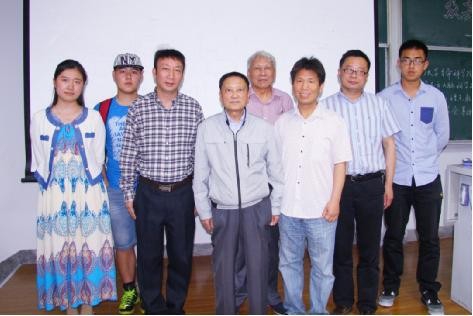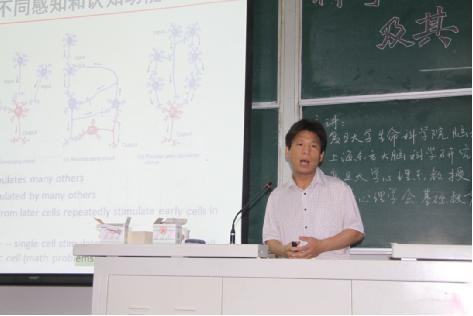
于玉国,男,1973年10月出生,现任复旦大学智能复杂体系基础理论与关键技术实验室、类脑智能科学与技术研究院, 教授 博士生导师。
计算神经科学实验室
智能复杂体系基础理论与关键技术实验室 学术主任(2020-)
复旦大学生命科学学院(2012-2020)
复旦大学医学神经生物学国家重点实验室(2013-)
上海市东方学者特聘教授(2013)跟踪计划(2017)
研究方向包括大脑神经信号动力学特性和生物物理机制、神经信息处理和神经计算、神经元和神经网络计算模型,仿生智能等。近年来构建了哺乳动物和人脑能量连接图谱三维数学模型,揭示脑皮层普适性信号传导和基础代谢依赖的大脑耗能规律和机制。从离子通道层次到神经元、神经网络和神经环路等多个尺度,研究了高等动物大脑如何实现低功耗神经网络线路连接、和高效节能处理信息和神经计算机制。在Nature, PNAS, Neuron, Physical Review Letters, J Neurosci, PLoS Comp Biol, J Cereb Blood Flow & Metabolism等学术期刊发表SCI论文70余篇,主持/承担国家基金项目10余项。
教育及工作经历:
1995年,兰州大学物理系学士学位。
2001年,南京大学凝聚态物理学博士学位。
2001-2004年,美国卡耐基梅隆大学神经认知基础中心博士后。
2005-2011年,耶鲁大学医学院神经生物学系博士后。
工作经历:
1、智能复杂体系基础理论与关键技术实验室 (2020- ) 教授
2、复旦大学表型研究院 (2018- ) 教授
3、复旦大学生命科学学院 (2014-2020) 教授
4、复旦大学医学神经生物学国家重点实验室 (2015- ) 研究员
5、复旦大学计算系统生物学中心 (2011-2014) 研究员、博士生导师。
6、耶鲁大学核磁共振成像中心 (2010-2012) 副研究员
学术兼职:
1、上海生物物理学会理事。
2、中国计算神经科学学会委员、自动化控制和生物工程协会委员。
3、Frontiers in Computational Neuroscience副主编。
4、Cognitive Neurodynamics编委。
主讲课程:
2013-至今复旦大学公共课:脑科学概论
2014-至今复旦大学生命科学学院专业选修课:计算神经生物学
2011-2012, 2017上海交通大学计算神经科学冬季短期培训班
招生专业:
生物物理
生物医学工程
复杂系统科学与工程
培养研究生情况:
培养研究生数十名。
研究方向:
1. 神经信息编码和神经计算理论:动作电位的时空发放模式是如何在大脑内表述自然界信号,又是如何在不确定的环境中实现有效信息提取、特征模式识别、学习和记忆等功能的?了解神经信息编码的机制和原理,以及神经计算的基本原则和理论将我们能清楚描述大脑高级功能的关键。技术手段:数学模型和神经电生理。
2. 神经系统的非线性动力学:神经系统的电生理、信息、认知和控制活动具有非线性、复杂性和随机性的本质,以及多层次、大系统、跨学科的特征。神经系统的动力学与控制问题是神经科学与非线性动力学、复杂网络系统等多学科有机融合的交叉研究领域,是神经信息学和计算神经科学的重要组成部分。
3. 神经元的数学模型构建:神经元是构成大脑的基本单元,它由神经细胞体、树突和轴突构成,神经元之间通过突触连接。神经元研究对象包括:1)不同种类的神经元;2)发育过程的神经元;3)不同脑区的神经元;4)不同物种的神经元(从无脊椎动物神经系统到灵长类动物脑,再到人脑),神经元的动力学机制的不同和离子机制的变化。
4. 局部和大尺度神经环路的计算模拟:结合功能核磁共振、神经电生理等大量实验数据,创建基于生物脑的真实神经环路数学模型,来研究学习和记忆的神经机制、研究高级认知活动比如决策的神经机理等,将有助于我们理解智能的产生。
5. 精神疾病的神经机制:在神经元水平上的钠、钾、钙等离子通道的异常;以及在网络水平上的兴奋性和抑制性神经元的比例失衡会导致各种神经疾病的产生。针对临床的癫痫、抑郁等精神疾病,我们利用计算机仿真数学模型来研究常见精神疾病发生发展的内在机理。
研究方式:结合计算神经科学、物理学、数学建模、信息理论、神经电生理、系统辨识论和神经脑影像等理论和实验方法手段进行综合交叉研究。
研究领域
类脑智能和计算神经科学
神经计算模型
神经编码理论
网络拓扑分析
感知融合机制
脑联接网络图谱
自组织学习算法
多感知融合模型
人脑低功耗机制
承担科研项目情况:
1. 皮层神经元能量效率的生物物理机制。
2. 视皮层视觉信息编码的动力学机制。
3. 大尺度嗅球神经网络气味编码的超级计算机仿真模拟。
代表成果:
(1) 课题组通过构建构建人眼视觉搜索时空概率模型揭示人眼目标搜索过程规律,遵循低能耗和高效率贝叶斯信息最大化的均衡原则
Zhou Y and Yu Y, (2021)
Human Visual Search Follows Suboptimal Bayesian Strategy Revealed by a Spatiotemporal Computational Model and Experiment.
Communications Biology, 4:34.
(2) 同纽约州立大学石溪分校葛少宇教授团队合作,构建了海马齿状回DG区能量计算模型,揭示新颖环境海马产生更多新生神经元的抑制神经活动调控网络能量机制
Wang X, Liu H, Morstein J, Novak AJE, Trauner DH, *Xiong Q, *Yu Y, and *Ge S, (2020)
Metabolic tuning of inhibition regulates hippocampal neurogenesis in the adult brain.
Proc Natl Acad Sci (PNAS), 117(41):25818-25829.
(3) 通过认知脑电实验研究揭示人脑在自然环境比在城市建筑环境具有更强alpha-theta振荡活动和网络联通性能
Chen Z, He Y, *Yu Y,(2020)
Attention restoration during environmental exposure via alpha-theta oscillations and synchronization,
Journal of Environmental Psychology, 68, 101406.
(4) 课题组通过电生理和计算模型综合交叉研究揭示哺乳动物脑皮层神经元和网络在生理温度具有最佳的信息编码和传输效率
Fu X and *Yu Y. (2019)
Reliable and efficient processing of sensory information at body temperature by rodent cortical neurons.
Nonlinear Dynamics, 98(1):215-31.
(5) 课题组和耶鲁大学核磁共振成像中心合作,构建人脑能量模型揭示皮层所有脑区能量分布图谱
*Yu Y, Herman P, Rothman DL, Agarwal D, & Hyder F. (2019).
Human brain gray matter energy map computed on the basis of cellular staining from BigBrain.
Journal of Cerebral Blood Flow & Metabolism, 39, 205.
(6) 课题组通过电生理和计算模型综合交叉研究揭示哺乳动物脑皮层神经元轴突纳钾离子通道电导密度决定了椎体神经元和中间神经元的放电特性
Zhang W, Fan, B, Agarwal D, Li T, & *Yu Y. (2019).
Axonal sodium and potassium conductance density determines spiking dynamical properties of regular-and fast-spiking neurons.
Nonlinear Dynamics, 95(2), 1035-1052.
(7) 构建神经元-星形胶质细胞网络计算模型,揭示胶质细胞调控皮层神经放电动力学的重要性,以及产生自发癫痫的胶质细胞Kir4.1通道和缝隙链接通道的机制
Du MM, *Yu Y and *Wu Y, (2018)
Astrocytic Kir4.1 channels and gap junctions account for spontaneous epileptic seizure,
PLoS Comp. Biol. 14(3): e1005877
(8) 构建了大鼠和人脑皮层能量预算计算模型,揭示了哺乳动物大脑能量分配的普适性规律
*Yu Y, Herman P, Rothman DL, Agarwal D and Hyder F, (2018)
Evaluating the gray and white matter energy budgets of human brain function,
Journal of Cerebral Blood Flow & Metabolism, 38(8):1339-1353.
(9) 和中山医院钟春玖教授合作,构建艾兹海默症血液维生素代谢物的生物标志物数学模型
Pan XL. et al, ... *Yu Y and *Zhong CJ. (*Co-PI) (2016).
Measurement of Blood Thiamine Metabolites for Alzheimer’s disease Diagnosis,
EBioMedicine, 26(3):155-162.
(10) 构建嗅球大尺度神经网络模型,解析生神经网络通过突触可塑性调控兴奋和抑制突触链接达到最佳比例实现了稀疏编码和侧向抑制功能
*Yu Y, Migliore M, Hines ML, and Shepherd GM (2014)
Sparse coding and lateral inhibition arising from balanced and unbalanced dendrodendritic excitation and inhibition.
Journal of Neuroscience 34: 13701-13713.
(11) 构建嗅球大尺度神经网络模型,研究了嗅球网络通过突触可塑性自组织演化出稀疏放电机制
*Yu Y, McTavish TS, Valenti C, Hines ML, Shepherd GM and Migliore M. (2013)
Sparse distributed representation of odors in a large-scale olfactory bulb circuit.
PLoS Comp. Biol., 9(3): e1003014.
(12) 构建哺乳动物皮层神经元计算模型,揭示了生理温度条件使高等动物皮层神经元实现动作电位放电的高效节能生物物理机制
Yu Y, Hill A. and McCormick DA. (2012)
Warm body temperature facilitates energy efficient cortical action potentials.
PLoS Comp. Biol., 8(4) e1002456.
(13) 率先发现皮层神经元轴突存在大量P/Q和N型钙离子通道亚型的实验证据
Yu Y, Maureira C and McCormick DA (2010)
P/Q and N channels control baseline and spike-triggered calcium levels in neocortical axons and synaptic boutons,
Journal of Neuroscience, 30: 118580-11869
(14) 通过实验和皮层神经元Hodgkin-Huxley三维计算模型相互验证,进一步证实作电位传输过程产生的轴向电流可导致动作电位快速上升相和阈值离散现象。得到国际同行普遍认可
Yu Y, Shu Y, Duque A, Haider B and McCormick DA (2008)
Cortical Action Potential Back-propagation Explains Spike Threshold Variability and Rapid-Onset Kinetics.
Journal of Neuroscience, 28: 7260-7272. PMCID: 2664555
(15) 构建皮层神经元Hodgkin-Huxley三维轴突和树突计算模型,在国际上首先提出动作电位传输过程产生轴向电流导致动作电位快速上升相和阈值离散的机制。在专业顶级期刊NATURE发表
McCormick DA, Shu Y and Yu Y (2007)
Hodgkin and Huxley model—still standing?
Nature. 445: E1-E2.
(16) 首次揭示皮层神经元对自然界信号的高度适应性,来自于皮层神经元对自然界信号1/f统计特性的适应性
*Yu Y, Richard RD and Lee TS (2005)
Preference of sensory neural coding for 1/f signals.
Phys. Rev. Lett., 94, 1081031-4
(17) 通过构建计算模型揭示视觉神经元对输入信号对比度适应的信息最大化原则和调控机制
*Yu Y, Richard RD and Lee TS. (2005)
Adaptive contrast gain control and information maximization.
Neurocomputing, 65-66 111-116
(18) 通过计算模型和数学分析揭示神经元响应曲线的阈值和饱和值在编码信号过程的调制机制
*Yu Y and Lee TS. (2003)
Adaptation of the transfer function of the Hodgkin-Huxley (HH) neuronal model.
Neurocomputing 52-54, 441-446
科研成果:
1. 在卡耐基-梅隆大学视觉认知实验室,通过神经行为和电生理实验方法,首次揭示视皮层对自然界信号的适应性信息处理机制,来自于视皮层神经元动力学特性对自然界信号统计特性长程相关特性(1/f特征)的适应性调谐效应。同时他还应用数学模型分析方法,刨析了神经元发放阈值和饱和值这些非线性特性对神经感知的被动适应性机制,并进一步解释了神经环路自适应性和信息编码最大化的关系。
2. 2006年,在耶鲁大学神经生物学系,他同合作者一起揭示了哺乳动物皮层神经元能以“数字-模拟”两种方式进行网络突触信号通讯,所建立的皮层神经元数学模型成功地解释了皮层神经元阈下电位和动作电位在细胞轴突上产生和传输的动力学机制。
3. 2007年,德国权威神经科学小组在《Nature》发表系列文章,指出基于低等动物神经电活动的经典Hodgkin-Huxley(HH)神经元理论模型无法解释高等动物皮层神经元动作电位产生的普遍特征:阈值离散特性和动作电位快速上升相等。本着对学术严谨的态度,于玉国和合作者在理论和实验两方面进行了重新分析和大量计算机仿真模拟,严格证实了皮层神经元动作电位产生时的阈值离散特性和动作电位快速上升相等特点是由动作电位在神经元轴突的空间传播导致,这一重要成果被国际顶尖杂志《Nature》发表,指出揭示经典HH神经元理论依然适用于哺乳动物皮层神经元的动作电位发放过程,驳斥了德国小组新建立的动作电位钠离子协同机制。
4. 2010年,通过对哺乳动物前额皮层脑切片进行双光子成像和膜片钳电生理记录手段,在该领域率先发现皮层神经元轴突上分布着大量的P/Q和N型钙离子通道,并最早揭示了轴突上的钙通道激活的钾通道对动作电位的发放率、发放精确时刻和波形产生具有重要的调制作用。
5. 2010年,通过大规模神经网络建模揭示了初级视皮层神经网络在对自然界信号进行信息处理时采用的同步和稀疏编码机制,表明大脑网络在信号处理方面遵从了能量最优化原则。这些突破性成果均发表在专业顶级杂志上。
6. 研究成果发现:当动物处于没有外界刺激的静息状态、尤其是麻醉状态,动物大脑皮层的神经电活动和对应区域的血氧信号出现了明显的去耦合状态。这一结论意味着,当前基于动物麻醉状态下来测量反映神经功能连接的脑影像的实验原理是不合理的,静息态脑功能连接的实验研究必须使动物处于适度的清醒状态。这一重要研究成果已经被国际著名期刊《自然通讯》考虑接收。
论文专著:
目前已经在国际一流学术期刊发表学术论文50多篇,研究成果分别发表在国际顶级学术刊物如《Nature》、《Physical Review Letters》、《Journal of Neuroscience》、《Neuron》、《PNAS》和《PLoS Computational Biology》等上面,同行总引用率超过1000次。
代表性期刊论文:
96 Mingyi Huang and Yuguo Yu* (2023). Wiring Cost Minimization: A Dominant Factor in the Evolution of Brain Networks across Five Species, 2023 CogSci (CCF-B).
95 Shen, Hao; Yu, Yuguo* (2023). Robust Evaluation and Comparison of EEG Source Localization Algorithms for Accurate Reconstruction of Deep Cortical Activity. Mathematics, 11(11):2450. https://doi.org/10.3390/math11112450
94 Chen, Zhongyu; Yu, Yuguo*; Xue, Xiangyang (2023). A Connectome-Based Digital Twin Caenorhabditis elegans Capable of Intelligent Sensorimotor Behavior. Mathematics, 11(11):2442. https://doi.org/10.3390/math11112442
93 Ruizhe Zheng*, Jun Li*, Yi Wang, Tian Luo, and Yuguo Yu (2023). ScatterFormer: Locally-Invariant Scattering Transformer for Patient-Independent Multispectral Detection of Epileptiform Discharges. 37th AAAI Conference on Artificial Intelligence, Washington, DC. https://arxiv.org/abs/2304.14919
92 Peng Tao#, Qifan Wang#, Jifan Shi#, Xiaohu Hao, Xiaoping Liu, Bin Min, Yiheng Zhang, Chenyang Li, He Cui*, Luonan Chen*. Detecting dynamical causality by intersection cardinal concavity. Accepted by Fundamental Research. (2023). https://doi.org/10.1016/j.fmre.2023.01.007
91 Qunxi Zhu*, Xin Li, Wei Lin* [2023], Leveraging neural differential equations and adaptive delayed feedback to detect unstable periodic orbits based on irregularly-sampled time series, CHAOS, Fast Track, Editor's Pick, 33(3): 031101. https://aip.scitation.org/doi/10.1063/5.0143839
90 Jingdong Zhang, Qunxi Zhu*, Wei Yang*, Wei Lin* [2023], SYNC: Safety-aware Neural Control for Stabilizing Stochastic Delay-Differential Equations, The Eleventh International Conference on Learning Representations (ICLR 2023). https://openreview.net/forum?id=_8mS2NE-HXN
89 庞艺伟; 于玉国*.基于生物脑网络连接特性的高效神经网络算法.计算机系统应用, 2023, 32(05): 196-203.
88 Zhang J, Huang M, Gu Y, *Chen A and *Yu Y, (2022),Visual-based spatial coordinate dominates probabilistic multisensory inference in Macaque MST-d disparity encoding. Brain Sciences, 12,1387. https://doi.org/10.3390/brainsci12101387
87 Yu, Yuguo*; Akif, Adil; Herman, Peter; Cao, Miao; Rothman, Douglas L.; Carson, Richard E.; Agarwal, Divyansh; Evans, Alan C.; Hyder, Fahmeed*. A 3D atlas of functional human brain energetic connectome based on neuropil distribution, Cerebral Cortex, 2023, 33(7): 3996-4012. https://doi.org/10.1093/cercor/bhac322
86 Zhang J, Gu Y, *Chen A and *Yu Y, (2022) Unveiling dynamical systems strategies for multisensory processing: from neuronal fixed-criterion integration to population Bayesian inference, Research, 2022,1-12. https://doi.org/10.34133/2022/9787040
85 Pei, Xinzhen; Xu, Guiying; Zhou, Yunhui; Tao, Luna; Cui, Xiaozhu; Wang, Zhenyu; Xu, Bingru; Wang, An-Li; Zhao, Xi; Dong, Haijun; An, Yan; Cao, Yang; Li, Ruxue; Hu, Honglin*; Yu, Yuguo*, 2022, A simultaneous EEG and eye-tracking dataset in elite athletes during alertness and concentration tasks, Scientific Data, 9(1): 1-15. https://doi.org/10.1038/s41597-022-01575-0
84 Du, Mengmeng; Li, Jiajia; Ying, Wu*; Yu, Yuguo*. (2022). A dynamics model of neuron-astrocyte network accounting for febrile seizures. Cognitive Neurodynamics, 16(2), 411-423. https://doi.org/10.1007/s11571-021-09706-w
83 Qi, Xiaoying; Wang, Yingying; Lu, Yingzhi; Zhao, Qi; Chen, Yifan; Zhou, Chenglin*; Yu, Yuguo*. (2022). Enhanced brain network flexibility by physical exercise in female methamphetamine users. Cognitive Neurodynamics, 1-17. https://doi.org/10.1007/s11571-022-09848-5
82 Jifan Shi, Kazuyuki Aihara, Tiejun Li, and Luonan Chen. Energy landscape decomposition for cell differentiation with proliferation effect. National Science Review, 9(8): nwac116, 2022.】 https://doi.org/10.1093/nsr/nwac116
81 Yang Li, Jifan Shi, and Kazuyuki Aihara. Mean-field analysis of Stuart-Landau oscillator networks with symmetric coupling and dynamical noise. Chaos, 32: 063114, 2022. https://doi.org/10.1063/5.0081295
80 Jingdong Zhang, Qunxi Zhu*, Wei Lin* [2022], Neural Stochastic Control, The Thirty-sixth Conference on Neural Information Processing Systems (NeurIPS 2022). https://openreview.net/forum?id=5wI7gNopMHW
79 Qnxi Zhu*, Yifei Shen, Dongsheng Li, Wei, Lin* [2022], Neural Piecewise-Constant Delay Differential Equations, Proceedings of the Thirty-Sixth AAAI Conference on Artificial Intelligence (AAAI 2022). https://ojs.aaai.org/index.php/AAAI/article/download/20911/20670
78 Zheng G, Li YZ, Qi XY, Zhang W, *Yu Y, (2021) Mental Calculation Drives Reliable and Weak Distant Connectivity While Music Listening Induces Dense Local Connectivity, Phenomics, 1.6: 285-298. https://doi.org/10.1007/s43657-021-00027-w
77 Lei, Yu; Li, Yuzhu; Yu, Lianchun; Xu, Longzhou; Zhang, Xin; Zheng, Gaoxing; Chen, Liang; Zhang, Wei; Qi, Xiaoying; Gu, Yuxiang*; Yu, Yuguo*; Mao, Ying.Faded Critical Dynamics in Adult Moyamoya Disease Revealed by EEG and fMRI.Oxidative Medicine and Cellular Longevity, 2021, 2021:1-17. https://doi.org/10.1155/2021/6640108
76 Pei Xinzhen; Qi Xiaoying; Jiang Yuzhou; Shen Xunzhang; Wang An Li; Cao Yang; Zhou Chenglin; Yu Yuguo*. (2021) Sparsely Wiring Connectivity in the Upper Beta Band Characterizes the Brains of Top Swimming Athletes. Frontiers in Psychology, 12:661632. https://doi.org/10.3389/fpsyg.2021.661632
75 Lu, Yingzhi; Qi, Xiaoying; Zhao, Qi; Chen, Yifan; Liu, Yanjiang; Li, Xiawen; Yu, Yuguo*; Zhou, Chengling*Effects of exercise programs on neuroelectric dynamics in drug addiction.Cognitive Neurodynamics, 2021, 15(1): 27-42. https://doi.org/10.1007/s11571-020-09647-w
74 Zheng, Gaoxing; Lei, Yu; Li, Yuzhu; Zhang, Wei; Su, Jiabin; Qi, Xiaoying; Chen, Liang; Zhang, Xin; Gu, Yuxiang*; Yu, Yuguo*; Mao, YingChanges in Brain Functional Network Connectivity in Adult Moyamoya Diseases. Cognitive Neurodynamics, 2021, 15(5): 861-872. https://doi.org/10.1007/s11571-021-09666-1
73 Zhou, Yunhui; Yu, Yuguo*, (2021) Human Visual Search Follows a Suboptimal Bayesian Strategy Revealed by a Spatiotemporal Computational Model and Experiment. Communications Biology, 4(1),1-16. https://doi.org/10.1038/s42003-020-01485-0
72 Wang, Xinxing; Liu, Hanxiao; Morstein, Johannes; Novak, Alexander J. E.; Trauner, Dirk; Xiong, Qiaojie*; Yu, Yuguo*; Ge, Shaoyu*.Metabolic tuning of inhibition regulates hippocampal neurogenesis in the adult brain, Proceedings of the National Academy of Sciences, 2020, 117(41): 25818-25829. https://doi.org/10.1073/pnas.2006138117
71 Lu Y, Qi X, Zhao Q, et al, *Yu Y and *Zhou C (2020) Effects of exercise programs on neuroelectric dynamics in drug addiction. Cognitive Neurodynamics, 1-16.
70 Lei, Yu; Song, Benshen; Chen, Liang; Su, Jiabin; Zhang, Xin; Ni, Wei; Yu, Yuguo; Xu, Bin; Yu, Lianchun*; Gu, Yuxiang*; Mao, Ying. Reconfigured functional network dynamics in adult moyamoya disease: a resting-state fMRI study. Brain Imaging and Behavior, 2020, 14(3): 715-727.
69 Chen Z, He Y, *Yu Y,(2020) Attention restoration during environmental exposure via alpha-theta oscillations and synchronization. Journal of Environmental Psychology, 68, 101406.
68 Yang, Lei; Jin, Yuqing; Wang, Xuejun; Yu, Bin; Chen, Renzhong; Zhang, Cong; Zhao, Yan; Yu, Yuguo; Liu, Yunqi; Wei, Dacheng*.Antifouling Field‐Effect Transistor Sensing Interface Based on Covalent Organic Frameworks. Advanced Electronic Materials, 2020, 6(5): 1901169.
67 Fu, Xin; Yu, Yuguo*.Reliable and efficient processing of sensory information at body temperature by rodent cortical neurons. Nonlinear Dynamics, 2019, 98(1): 215-231.
66 YZ Li, GX Zheng, XY Qi, *Yu Y. (2019) Critical Dynamics Characteristics of Human Brain EEG Activity During Music-listening State and Resting State, Journal of Fudan University 05-0586-10.
65 Yu, Bin; Jin, Yuqing; Shen, Yi; Yang, Yenan; Wang, Gang; Zhu, Haiying*; Yu, Yuguo*; Wang, Jingqiang*.Loss of homeoprotein Msx1 and Msx2 leading to athletic and kinematic impairment related to the increasing neural excitability of neurons in aberrant neocortex in mice. Biochemical and Biophysical Research Communications, 2019, 516(1): 229-235.
64 *Yu Y, Herman P, Rothman DL, Agarwal D, & Hyder F. (2019). Human brain gray matter energy map computed on the basis of cellular staining from BigBrain. Journal of Cerebral Blood Flow & Metabolism, 39, 205.
63 李玉珠; 郑高兴; 齐晓英; 于玉国*.人脑聆听轻音乐和静息状态下的EEG临界动力学特性.复旦学报(自然科学版), 2019, 58(05): 586-595.
62 Qu, Guojie; Fan, Boqiang; Fu, Xin; Yu, Yuguo*.The impact of frequency scale on the response sensitivity and reliability of cortical neurons to 1/fβ input signals. Frontiers in Cellular Neuroscience, 2019, 13: 311.
61 Zhang Wen; Fan Boqiang; Agarwal Divyansh; Li Tun; Yu Yuguo *. Axonal sodium and potassium conductance density determines spiking dynamical properties of regular-and fast-spiking neurons. Nonlinear Dynamics, 2019, 95(2): 1035-1052.
60 Yu Lianchun; Shen Zhou; Wang Chen; Yu Yuguo*.Efficient coding and energy efficiency are promoted by balanced excitatory and inhibitory synaptic currents in neuronal network.Frontiers in cellular neuroscience, 2018, 12: 123.
59 Du, Mengmeng; Li, Jiajia; Chen, Liang; Yu, Yuguo*; Wu, Ying*.Astrocytic Kir4.1 channels and gap junctions account for spontaneous epileptic seizure,PLoS Computational Biology, 2018, 14(3): e1005877.
58 Zheng, Gaoxing; Qi, Xiaoying; Li, Yuzhu; Zhang, Wei; Yu, Yuguo*.A comparative study of standardized infinity reference and average reference for EEG of three typical brain states. Frontiers in Neuroscience. 2018;12:158.
57 Liu, Yujiang; Yue, Yuan; Yu, Yuguo; Liu, Liwei; Yu, Lianchun*.Effects of channel blocking on information transmission and energy efficiency in squid giant axons. Journal of Computational Neuroscience, 2018, 44(2): 219-231.
56 Zhou Shanglin; Yu Yuguo*.. Synaptic E-I balance underlies efficient neural coding,Frontiers in Neuroscience. 2018,12:46.
55 Wang YiYan; Wang Pingxiao; Yu Yuguo*.Decoding English alphabet letters using EEG phase information, Frontiers in Neuroscience, 2018, 12: 62.
54 Yu Yuguo*; Herman Peter; Rothman Douglas L; Agarwal Divyansh; Hyder Fahmeed*. Evaluating the gray and white matter energy budgets of human brain function, Journal of Cerebral Blood Flow & Metabolism, 2018, 38(8): 1339-1353.
53 Yu, Jiao; Yu, Yuguo*.Therapeutic effects of targeted nursing interventions combined with auricular-plaster therapy on anxiety level and life quality of Hepatitis B patients.Pakistan Journal of Pharmaceutical Sciences, 2018, 31(4): 1375-1378.
52 Li, Q.; Li, H.; Jiang, H.; Feng, Y.; Cui, Y.; Wang, Y.; Ji, Y.; Yu, Y.; Li, W.; Xu, C.; Yu, S.; Zhuang, R.; Liu, T.*.Predictive factors of trastuzumab-based chemotherapy in HER2 positive advanced gastric cancer: a single-center prospective observational study.Clinical and Translational Oncology, 2018, 20(6): 695-702.
51 Yu Lianchun; Yu Yuguo*. Energy-Efficient Neural Information Processing in Individual Neurons and Neuronal Networks, Journal of Neuroscience Research, 2017, 95(11): 2253-2266.
50 何裕嘉; 张玮; 郑高兴; 于玉国.音乐增强大脑网络小世界特性.复旦学报(自然科学版), 2017, 56(06): 692-700+711.
49 Li J, Xie Y, Yu Y, Wu Y, (2017) A neglected GABAergic astrocyte: Calcium dynamics and involvement in seizure activity. Sci. China Technol. Sci. 60: 1003.
48 范博强; 何裕嘉; 于玉国.自然界信号的1/f特征和感觉神经系统响应特性.中国科学:生命科学 , 2016, (04): 374-384.
47 Fan, BQ, He Y, *Yu Y (2016) 1/f Characteristic in Natural Signals and Sensory Neural Response Properties. SCIENTIA SINICA Vitae, 46(4), 374-384.
46 Chen, Zheng; He, Yujia; Yu, Yuguo *. Enhanced functional connectivity properties of human brains during in- situ nature experience, PeerJ, 2016, 4: e2210.
45 Ye, Weijie; Liu, Shenquan*; Liu, Xuanliang; Yu, Yuguo.A neural model of the frontal eye fields with reward-based learning. Neural Networks, 2016, 81: 39-51.
44 Ju H, Hines ML, *Yu Y .Cable energy function of cortical axons,Scientific Reports, 2016, 6: 29686.
43 Yu LC, Zhang C, Liu YW and *Yu YG (2016) Energy-efficient population coding constrains network size of a neuronal array system, Scientific Reports, 6:193691-8 (2016). PMC4725972
42 Zhou S, Migliore M and *Yu YG (2016) Odor experience facilitates sparse representations of new odors in a large-scale olfactory bulb model. Front in neuroanat. 2016, 10:10. PMCID: 4749983
41 Pan, Xiaoli; Fei, Guoqiang; Lu, Jingwen; Jin, Lirong; Pan, Shumei; Chen, Zhichun; Wang, Changpeng; Sang, Shaoming; Liu, Huimin; Hu, Weihong; Zhang, Hua; Wang, Hui; Wang, Zhiliang; Tan, Qiong; Qin, Yan; Zhang, Qunying; Xie, Xueping; Ji, Yong; Cui, Donghong; Gu, Xiaohua; Xu, Jun; Yu, Yuguo*; Zhong, Chunjiu*Measurement of Blood Thiamine Metabolites for Alzheimer’s disease Diagnosis, EBioMedicine, 26(3):155-162.
40 Zhang W, Yang HL, Song JJ, Chen M, Dong Y, Lai B, Yu Y, Ma L and Zheng P, (2015) DAMGO depresses inhibitory synaptic transmission via different downstream pathways of μ opioid receptors in ventral tegmental area and periaqueductal gray. Neuroscience 301, 144-154
39 Zheng Chen#*; Yujia He#; Yu Guo Yu*.Natural environmentpromotes deeper brain functional connectivity than built environment.BMC Neuroscience, 2015, 16: 294-295.
38 Boqiang Fan; Yu Guo Yu*.Key factorsdominating the neural coding preference to 1/f signal.BMC Neuroscience, 2015, 16: 296-297.
37 Wen Zhang; Boqiang Fan; Yu Guo Yu*.Axon initial segment potassium channel density in cortical neurons.BMC Neuroscience, 2015, 16: 295-296.
36 Li, Jiajia; Liu, Shaobao; Liu, Weiming; Yu, Yuguo; Wu, Ying.Suppression of firing activities in neuron and neurons of network induced by electromagnetic radiation.Nonlinear Dynamics, 2016, 83(1-2): 801-810.
35 Zhou Shanglin; Fan Boqiang; Migliore Michele; Yu Yuguo.Learning experience facilitates sparse coding of new odors in a large-scale olfactory bulb model.BMC Neuroscience, 2015, 16(Suppl 1).
34 Fan B.Q.; Yu Y.G.Computational investigation of biophysical mechanism of individual neurons to 1/f signal.PLoS Computational Biology, 2015, in submission.
33 Yu, Yuguo*; Migliore, Michele; Hines, Michael L.; Shepherd, Gordon M. Sparse Coding and Lateral Inhibition Arising from Balanced and Unbalanced Dendrodendritic Excitation and Inhibition. Journal of Neuroscience, 2014, 34(41): 13701-13713.
32 Yu Yuguo*; Karbowski Jan; Sachdev Robert N S; Feng Jianfeng.Effect of temperature and glia in brain size enlargement and origin of allometric body-brain size scaling in vertebrates. BMC Evolutionary Biology, 2014, 14:71801-71814. PMCID: 4193995
31 Yu Guo Yu*. Constant Warm Body Temperature Ensures High Response Reliability of Neurons in Endothermic Brains. Austin J Comput Biol Bioinform, 2014; 1(1): 5.
30 Yu, Yuguo*; McTavish, Thomas S.; Hines, Michael L.; Shepherd, Gordon M.; Valenti, Cesare; Migliore, Michele. Sparse Distributed Representation of Odors in a Large-scale Olfactory Bulb Circuit. PLoS Comput Biol, 9(3):e1003014.
29 Carnevale NT, Cheung K, Crasto CJ, Hines ML, Marenco L, McDougal RA, Migliore M, Miller PL, Morse TM, Neymotin SA, Shepherd GM, Wang R and Yu YG (2013). Senselab databases integrate neuronal data and modeling. Front. Neuroinform. Neuroinformatics 2013. doi: 10.3389/conf.fninf.2013.09.00079.
28 Yuguo Yu*. Properties of cortical axons for energy efficient cortical action potentials. BMC Neuroscience. 2012, 13: P6.
27 Yuguo Yu* Temperature-fastened sodium inactivation accounts for energy efficient cortical action potentials in mammalian brains. BMC Neuroscience. 2012, 13:P5.
26 Yu Yuguo*; Hill Adam P; McCormick David A. Warm body temperature facilitates energy efficient cortical action potentials. PLoS Computational Biology, 2012, 8(4): 16.
25 Foust AJ, Yu YG, Popovic M, Zecevic D and McCormick DA (2011) Somatic Membrane Potential and Kv1 Channels Control Spike Repolarization in Cortical Axon Collaterals and Presynaptic Boutons. Journal of Neuroscience, 2011, 31(43): 15490-15498.
24 Yu YG, Maureira C and McCormick DA (2010) P/Q and N channels control baseline and spike-triggered calcium levels in neocortical axons and synaptic boutons, JJournal of Neuroscience, 2010, 30(35): 11858-11869.
23 Haider B, Krause MR, Duque A, Yu YG, Touryan J, Mazer JA, McCormick DA (2010) Synaptic and network mechanisms of sparse and reliable visual cortical activity during non-classical receptive field stimulation.Neuron, 2010, 65(1): 107-121.
22 Ros H., Sashdev, R.N.S., Yu Y.G., Sestan, N., and McCormick D.A. Neocortical Networks Entrain Neuronal Circuits in Cerebellar Cortex. Journal of Neuroscience, 2009, 29(33): 10309-10320.
21 Yu YG, Shu Y, Duque A, Haider B and McCormick DA (2008) Cortical Action Potential Back-propagation Explains Spike Threshold Variability and Rapid-Onset Kinetics. Journal of Neuroscience, 2008, 28(29): 7260-7272.
20 McCormick DA, Shu Y and Yu YG (2007) Hodgkin and Huxley model—still standing? Nature. 445: E1-E2.
19 Shu Y, Yu YG, Yang J and McCormick DA (2007) Selective control of cortical axonal action potentials by a slowly inactivating K+ current. Proceedings of the National Academy of Sciences of the United States of America, 2007, 104(27): 11453-11458.
18 Shu Y, Duque A, Yu YG, Haider B and McCormick DA (2007) Properties of action potential initiation in neocortical pyramidal cells: evidence from whole cell axon recordings. J Neurophysiol, 2007, 97(1): 746-760.
17 Haider B., Duque A., Hasenstaub A.R., Yu Y.G., McCormick D.A. Enhancement of visual responsiveness by spontaneous local network activity in vivo. Journal of Neurophysiology, 2007, 97(6): 4186-4202.
16 Shu Y, Hasenstaub A, Duque A, Yu YG and McCormick DA (2006) Modulation of intracortical synaptic potentials by presynaptic somatic membrane potential. Nature, 2006, 441(7094): 761-765.
15 Yu YG*, Richard RD and Lee TS (2005) Preference of sensory neural coding for 1/f signals. Physical Review Letters, 2005, 94(10): 108103-4.
14 Yu YG*, Potetz B and Lee TS (2005) The role of spiking nonlinearity in contrast gain control and information transmission. Vision Research, 2005, 45(5): 583-592.
13 Yu, Y.G., Richard, R.D., and Lee, T.S. Adaptive contrast gain control and information maximization. Neurocomputing, 2005, 65: 111-116.
12 *Yu, Y. G., Liu, F., Wang W. and Lee, T.S. Optimal synchrony state for maximal information transmission. NeuroReport, 2004, 15(10): 1605-1610.
11 Wang S, Liu F, Wang W and Yu YG (2004) Impact of Spatially correlated noise on neuronal firing. Physical Review E, 2004, 69(1): 7. 0119091-0119097.
10 Yu, Y. G., Liu, F., Wang, J. and Wang, W. Synchronized Rhythmic Oscillation in a Noisy Neural Network. Journal of the Physical Society of Japan, 2003, 72(12): 3291-3296.
9 Yu YG* and Lee TS (2003) Dynamical mechanisms underlying contrast gain control in single neurons. Physical Review E, 2003, 68(1): 7.
8 Yu, Y.G., and Lee, T.S.Adaptation of the transfer function of the Hodgkin-Huxley (HH) neuronal model. Neurocomputing 52-54, 441-446 (2003)
7 Romero, R.D., Yu, Y. G., Afshar, P., Lee, T.S. Adaptation of the temporal receptive fields of Macaque V1 neurons.Neurocomputing 52-54:135-140 (2003).
6 Yu, Y. G*., Wang, W., Wang, J.F., and Liu, F. Resonance-enhanced signal detection and transduction in Hodgkin-Huxley neuronal systems.Physical Review E, 63, 0219071-02190712, (2001).
5 Yu, Y.G., Liu, F., and Wang W. Spike timing precision for a neuronal array with periodic signal.Physics Letters A, 2001, 282(1-2): 23-30.
4 Liu, F*; Yu, Y. G., and Wang, W.Signal-to-noise gain in nervous systems.Physical Review E - Statistical Physics, Plasmas, Fluids, and Related Interdisciplinary Topics, 2001, 63(5): 051912-0519124 .
3 Yu, Y. G., Liu, F., and Wang, W.Frequency sensitivity in Hodgkin-Huxley systems.Biological Cybernetics, 2001, 84(3): 227-233.
2 Yu, Y. G., and Wang, W. Generation of Spontaneous Synchronized Rhythm and its Role in Information Processing. Chinese Physics Letters, 2001, 18(2): 295-298.
1 Liu, F., Yu, Y. G., and Wang, W.Information Representation and Its Application to Stochastic Resonance. Journal of the Physical Society of Japan, , 2000, 69(12): 4107-4111.
发表会议论文:
7 Yu, Y*; Herman, P; Rothman, D L; Agarwal, D; Hyder, F.Human brain gray matter energy mapcomputed on the basis of cellular staining from BigBrain.29th International Symposium on Cerebral Blood Flow, Metabolism and Function / 14th International Conference on Quantification of Brain Function with PET (BRAIN and BRAIN Pet), Yokohama, Japan, 2019-07-04 to 2019-07-07.
6 Li, Yuzhu; Zheng, Gaoxing; Qi, Xiaoying; Yu, Yuguo*.Critical brain dynamics in the EEG resting state.23rd IEEE International Conference on Digital Signal Processing (DSP), 2018-11-19 To 2018-11-21.
5 Yu Y*; Hyder F.Human brain energy map computed on the basis of cellular staining from BigBrain.28th International Symposium on Cerebral Blood Flow, Metabolism and Function / 13th International Conference on Quantification of Brain Function with PET, Berlin, Germany, 2017-04-01 to 2017-04-04.
4 Yu Y*; Hyder F.Evaluating the gray and white matter energy budgets of human brain function.28th International Symposium on Cerebral Blood Flow, Metabolism and Function / 13th International Conference on Quantification of Brain Function with PET, Berlin, Germany, 2017-04-01 to 2017-04-04.
3 Yu, Y.; Yu, Yuguo.Principles of energy demand in gray and white matter of the human brain.27th International Symposium on Cerebral Blood Flow, Metabolism and Function / 12th International Conference on Quantification of Brain Function with PET, 2015-06-27 To 2015-06-30.
2 He Yujia; Chen Zheng*; Yu Yuguo*.Visual Experience in Natural Environment Promotes Better Brain Functions Than Built Environment?5th International Conference on Cognitive Neurodynamics (ICCN), 2015-06-03 To 2015-06-07.
1 于玉国.动作电位产生和传输过程高效节能的动力学机制.第二届全国神经动力学学术会议论文集.
荣誉奖励:
1、上海市优秀学术带头人(2021)。
2、上海市东方学者跟踪计划(2017)。
3、上海市东方学者(2013)。
“神奇大脑及其潜能开发”报告讨论会举行

5月28日晚,由复旦生命与潜力学社、复旦“语言•大脑•计算”交叉学科平台共同主办的,主题为“神奇大脑及其潜能开发”的讲座在三教3206如期举行,为这次校庆的“科学盛宴”添上了浓墨重彩的一笔。讲座特别邀请了复旦大学生命科学院于玉国教授,上海东方大脑科学研究所所长王桂松教授,复旦大学社政院心理学系张学新教授,上海心理学会基础教育专委会主任秦启庚教授,四位着重不同侧面的大脑科学专家,分别做了精彩演讲。参加这次会议的嘉宾有:上海新华医院神经内科楼之茵博士,瑞梅医院投资管理公司邱世绘总监、张玉平经理,国家高级营养师李瑞,上海心仪电子科技有限公司心理健康事业部马保记经理以及人类潜力学学者、生命与潜力学社导师之一顾平尔等。

报告会在生命与潜力学社社长陈悦热忱的欢迎词中拉开序幕,首先主讲的是于玉国教授,他从物理定律、宇宙的神奇构造谈到大脑神经元的分子机制;从大脑神经元之间是如何通讯如何相互作用谈到了人的学习、记忆、运动和认知功能。阐述了人脑的复杂结构和神奇功能。
作为一名脑外科的临床医生,王桂松所长给大家介绍了关于人脑疾病的相关知识,例如阿尔茨•海默症,癫痫,抑郁症的发病起因,临床症状,治疗现状,以及如何预防。现场听众纷纷提问,与脑病专家热烈互动。
接下来,社政院张学新教授主要介绍了人类不同的心理学思维模式,如逻辑思维,形象思维,创造思维,批判性思维等,并分析了 “对分课堂”的教学模式是如何激发学生的学习积极性和主动性的。
毕生致力于青年和中小学生心理健康教育的秦启庚主任,就多年教学经验阐述了关爱青少年心理健康的紧迫性和重要性。并分享了如何维护青年学生心理健康,有效提高他们的学习能力和改善心理实验与教学方法等方面的切身体会。引发了听众对于国内心理学健康教育现状的思考,并对当前的紧迫问题展开了真切和热烈的讨论。
讲座尾声,秦启庚主任引进的上海心仪电子科技有限公司心理健康事业部经理马保记带队一行五人,对五台用于训练青年学生学习能力的仪器做了当场操作演示。现场听众纷纷热烈地参与测试。
值得一提的是,本次参加报告会的来宾,大多是校内外各行各业中有关大脑科学涉足较深的学者和青年探索者,他们不仅是热情的听众,更是互动的专题研讨积极分子。
报告会最后,四位不同领域的大脑科学专家,分别从自然科学,临床医学,心理健康实践等方面梳理和揭示了人类神奇大脑及其潜能开发的根本问题和最新进展。
一场精彩的“视听盛宴”,一场别开生面的思维碰撞,在听众热烈的掌声和依恋不舍的交流中,逐渐落下帷幕。但是,与以往不同的是,新的序曲又将拉开帷幕。这次的后续活动,在专家和青年学者们的共同应求声中将逐一展开。如:于玉国教授将同学者们在实验室共同进行脑科学方面尖端疑难问题的研讨、实验和测试。又如:复旦生命与潜力学社将组织有关专题小组参观访问东方脑研所,新华医院等,研讨与梳理有关智商、记忆力和阿尔茨•海默症的科学测试专题。又如:东方大脑科学研究所所长王桂松教授已发出邀请,欢迎有关方学者报名参加新创立的张江大脑科学创新平台。凡此等等,这次报告会,有如多米诺骨牌,它的连锁反应不断,人们期望专家学者们加紧迈向科学前沿的脚步,瞄准新锐,不断创新,不断树标!
来源:脑科学研究院 2015-06-12
最新研究进展:稀疏编码和侧向抑制的神经突触机制
Sparse coding and lateral inhibition arising from balanced and unbalanced dendrodendritic excitation andinhibition.
Yu et al.,J Neurosci. 2014 Oct 8;34(41):13701-13. doi: 10.1523/JNEUROSCI.1834-14.2014.
我们最近刚发表在《神经科学通讯》的这篇文章揭示了神经网络系统普遍存在的稀疏编码侧向抑制的突触机制。应用嗅球系统(因为嗅球内部兴奋性神经元(僧帽细胞)和抑制性神经元(颗粒细胞)非常规则组合成神经网络,易于研究)作为研究对象,构建了一个大尺度神经网络模型。通过研究兴奋性和抑制性突触强度在学习过程中动力学演化规律,和最终形成的稀疏编码状态和侧向抑制程度,我们发现,当兴奋性和抑制性突触强度达到最佳比例时(约为1:1.5和1:2这个范围),神经元集群的稀疏发放度最高。而与这些神经元相邻的没有直接接受信号输入的神经元的兴奋性和抑制性突触强度出现极大地比例失衡(<1:100),这导致了侧向抑制这种现象。神经元的稀疏发放和侧向抑制共同作用使得神经网络出现最为高效的稀疏编码。
Abstract
The precise mechanism by which synaptic excitation and inhibition interact with each other in odor coding through the unique dendrodendritic synaptic microcircuits present in olfactory bulb is unknown. Here a scaled-up model of the mitral-granule cell network in the rodent olfactory bulb is used to analyze dendrodendritic processing of experimentally determined odor patterns. We found that the interaction between excitation and inhibition is responsible for two fundamental computational mechanisms: (1) a balanced excitation/inhibition in strongly activated mitral cells, leading to a sparserepresentation of odorant input, and (2) an unbalanced excitation/inhibition (inhibition dominated) in surrounding weakly activated mitral cells, leading to lateral inhibition. These results suggest how both mechanisms can carry information about the input patterns, with optimal level of synaptic excitation and inhibition producing the highest level of sparseness and decorrelation in the network response. The results suggest how the learning process, through the emergent development of these mechanisms, can enhance odor representation of olfactory bulb.
来源:于玉国博客 2014-10-11
重要发现:动物大脑尺寸急剧增大的两个关键因素和理论机制
BMC Evol Biol. 2014 Oct 3;14(1):178. [Epub ahead of print]
Effect of temperature and glia in brain size enlargement and origin of allometric body-brain size scaling in vertebrates.
Yu Y, Karbowski J, Sachdev R, Feng J.
长期以来,已经普遍认识到,在同样身体质量的情况,哺乳动物和鸟类的大脑质量超过冷血动物的数十倍。考虑到大脑神经元耗能极高,是身体细胞的10倍,在几乎相同的新陈代谢机制下,同样的身体质量,哺乳动物是如何向耗能极高的大脑供应能量的?而进化上,在2亿年前的爬行动物和恐龙时代,早期的哺乳动物又是什么力量驱动自然界演化出超过爬行动物数十倍 大脑的呢?
通过对数十类、上千种动物的大脑和身体质量、新陈代谢、温度、胶质细胞含量等数据进行了全面分析,我们首次发现温度和胶质细胞和大脑尺寸的增加紧密相关,我们建立了一个普适性的大脑-温度数学模型揭示了,温度越高,身体产能越大、神经元耗能减少等规律;也揭示了胶质细胞在大脑内数量的迅速增长,而胶质细胞耗能极少的特点,构成了促进温血动物大脑出现爆炸性增长的两个关键因素。我们这个温度和胶质细胞促进大脑尺寸膨胀增长的理论给出了一个理论预测,导致了一个新的发现:即在地球上,冷血动物生活在越温暖的地区,大脑的尺寸越大。我们收集和分析了近千种鱼类数据,验证了这个理论预测的正确性。
(后记:这篇文章前后历经2年时间,通过和国内同行、国际同行的各种讨论,针对各种争议,做了各种分析验证,数学模型的建立也是在每一个细节上力求坚实有据,目前为止,这是最为满意,结论的正确性最为信服的一稿。我头上也因此多了数根白发阿,文章前后修改超过100多稿。)
Abstract
BackgroundBrain signaling requires energy. The cost of maintaining and supporting energetically demanding neurons is the key constraint on brain size. The dramatic increase in brain size among mammals and birds cannot be understood without solving this conundrum: larger brains, with more neurons, consume more energy.ResultsHere we examined the intrinsic relationships between metabolism, body-brain size ratios and neuronal densities of both endothermic and ectothermic animals. We formulated a general model to elucidate the key factors that correlate with brain enlargement, and the origin of allometric body-brain size scaling. This framework identified temperature as a critical factor in brain enlargement via temperature-regulated changes in metabolism. Our framework predicts that ectothermic animals living in tropical climates should have brain sizes that are several times larger than those of ectothermic animals living in cold climates. This prediction was confirmed by data from experiments in fish brains. Our framework also suggests that a rapid increase in the number of less energy-demanding glial cells may be another important factor contributing to the ten-fold increase in the brain sizes of endotherms compared with ectotherms.ConclusionsThis study thus provides a quantitative theory that predicts the brain sizes of all the major types of animals and quantifies the contributions of temperature-dependent metabolism, body size and neuronal density.
来源:于玉国博客 2014-10-11
躬身做学问 赤诚卫初心
——记复旦大学计算系统生物学中心于玉国研究员
不久前,从复旦大学计算系统生物学中心传出喜讯,该中心计算神经科学实验室负责人于玉国研究员由于在所从事的研究领域中建功无数,许多研究和发现都具有极重要的意义,被授予2013年度上海高校特聘教授(东方学者)称号。
我们在了解于玉国研究员成长历程中鲜为人知的故事时,也揭开了这位计算神经科学领域的青年才俊传奇式的科研轨迹。从一名学习物理出身的大学生成长为一名卓有建树的跨学科领域的专家,于玉国始终带着炽烈而坚定的信念,带着朴实而淡定的笑容,带着宽厚而温良的品格,一路前行……
对理想的执著
生在普通家庭的于玉国,从小就很喜欢读书。由于家境并不富裕,家里儿童读物很少,当医生的父亲的一本专业书籍《医学心理学》就成了他儿童时代经常阅读的一本科学启蒙书。这样一本普通的医学专业书,摆在书店的架子上可能很少有人关注,但却因为含有一些心理物理学的有趣的实验测试以及一些简单的对心理、意识等认知科学的简介,启迪了于玉国对大脑奥秘的好奇心。他少年的头脑经常被这本书中的有趣知识所吸引,走在路上,坐在草地里,躺在屋顶上,他的眸子坦荡空灵,充满好奇,在阅读,在思考,在吸收:人的大脑原来如此神奇,人的精神世界原来如此幻化莫测,人的意识产生的机制是如此神秘……
《医学心理学》燃起童年于玉国对科学的热爱。路漫漫其修远兮,他从此就跟随着心灵的选择,走上求索脑科学的道路。
1991年,于玉国考上兰州大学物理系。由于当时国内的神经科学发展还很缓慢,专业非常少,他选择物理系就读,对他将来从事研究其实打下了很好的数理科学方面的基础。走进大学意味着新的起点。在大学里,图书馆成了乐园,他广泛阅读了许多有关自然万物规律、尤其是涉及探索大脑奥秘的科普书籍,并立下将来从事脑科学研究的理想。
为了向心中热爱的专业靠近,本科即将毕业时,于玉国跑了两趟北京,想去北京生物物理所读研究生,但彼时国内跨专业招生非常严格,没有神经生物学专业基础的他,最后接受了保送本校物理系研究生的机会,但这并没有浇灭他对神经科学的向往。硕士阶段,于玉国跟随导师研究当时热门的纳米材料,成果突出,但执着于脑科学兴趣的他,先后去了上海脑所和复旦大学,希望攻读神经科学的博士学位。国内学科的壁垒再一次拒绝了有志于跨学科研究神经科学的一名物理系研究生。恰逢此时,于玉国偶然读到南京大学物理系王炜教授的一篇计算神经科学的文章,用计算模型和非线性动力学的方法来研究神经元和神经网络的神经信息处理机制。于玉国难掩心中喜悦,向王教授发出报考博士生的信函,之后如愿进入南京大学物理系生物物理研究所,跟从王炜教授,成为国内最早的一批应用物理学的手段来研究神经动力学和神经信息处理的博士生之一。
十年磨一剑
一进入到计算神经科学的世界,好奇心与攻关精神使于玉国动力十足,他风雨兼程,在心灵力量的引领下扬帆启航。2001年博士毕业后,于玉国远渡重洋,先后到卡耐基-梅隆大学和耶鲁大学开展研究工作。期间,在这个原来从未涉猎的领域里,他以非同一般的毅力和悟性,获得一系列突破成果。
在卡耐基-梅隆大学视觉认知实验室,他通过神经行为和电生理实验方法,首次揭示视皮层对自然界信号的适应性信息处理机制,来自于视皮层神经元动力学特性对自然界信号统计特性长程相关特性(1/f特征)的适应性调谐效应。同时他还应用数学模型分析方法,刨析了神经元发放阈值和饱和值这些非线性特性对神经感知的被动适应性机制,并进一步解释了神经环路自适应性和信息编码最大化的关系。
2006年,在耶鲁大学神经生物学系,他同合作者一起揭示了哺乳动物皮层神经元能以“数字-模拟”两种方式进行网络突触信号通讯,所建立的皮层神经元数学模型成功地解释了皮层神经元阈下电位和动作电位在细胞轴突上产生和传输的动力学机制。2007年,德国权威神经科学小组在《Nature》发表系列文章,指出基于低等动物神经电活动的经典Hodgkin-Huxley(HH)神经元理论模型无法解释高等动物皮层神经元动作电位产生的普遍特征:阈值离散特性和动作电位快速上升相等。本着对学术严谨的态度,于玉国和合作者在理论和实验两方面进行了重新分析和大量计算机仿真模拟,严格证实了皮层神经元动作电位产生时的阈值离散特性和动作电位快速上升相等特点是由动作电位在神经元轴突的空间传播导致,这一重要成果被国际顶尖杂志《Nature》发表,指出揭示经典HH神经元理论依然适用于哺乳动物皮层神经元的动作电位发放过程,驳斥了德国小组新建立的动作电位钠离子协同机制。2010年,于玉国通过对哺乳动物前额皮层脑切片进行双光子成像和膜片钳电生理记录手段,在该领域率先发现皮层神经元轴突上分布着大量的P/Q和N型钙离子通道,并最早揭示了轴突上的钙通道激活的钾通道对动作电位的发放率、发放精确时刻和波形产生具有重要的调制作用。
2010年于玉国还通过大规模神经网络建模揭示了初级视皮层神经网络在对自然界信号进行信息处理时采用的同步和稀疏编码机制,表明大脑网络在信号处理方面遵从了能量最优化原则。这些突破性成果均发表在专业顶级杂志上。
在物理学、生物物理、神经生物学实验和计算神经科学等多学科接受了系统学术训练之后,于玉国娴熟地应用跨学科技术方法对神经科学的前沿课题进行综合交叉研究,取得了一个接一个的重要突破,得到了国际学术界广泛承认。
逐浪在脑前沿
把实验神经科学和定量化的数理科学联系在一起,综合运用物理、统计、数学以及工程学的概念和分析工具来科学研究大脑的功能,是国际脑研究领域的大趋势,也促成了多学科交叉的计算神经科学这门学科在世界各国高校和研究所的兴起和蓬勃发展。作为计算神经科学研究领域的佼佼者之一,于玉国看到了国内计算神经科学发展缓慢的状况,也预见到推动计算-实验神经科学综合交叉研究领域的绝好机遇。经认真思虑,他决定拒绝美国两处研究所提供的研究科学家职位,回国工作。
2011年,于玉国作为正高级研究员引进到复旦大学计算系统生物学中心。加入中心后,他积极参与中心的发展,并且在学术上也屡有建树。他近期的一项重要研究,是通过计算模型结合神经生物学实验首次提出高等动物所具有的37度体温是神经元产生动作电位高效节能的重要源由,并揭开了体温优化皮层动作电位能量效率的生物物理机制。另外恒定的体温对维护神经元进行精确的信息处理和神经计算都起到至关重要的作用。他进一步的研究还揭示,体温的进化有可能是导致哺乳动物拥有数十倍于冷血动物大脑的关键因素。
最近,他的一个计算和实验研究还发现:当动物处于没有外界刺激的静息状态、尤其是麻醉状态,动物大脑皮层的神经电活动和对应区域的血氧信号出现了明显的去耦合状态。这一结论意味着,当前基于动物麻醉状态下来测量反映神经功能连接的脑影像的实验原理是不合理的,静息态脑功能连接的实验研究必须使动物处于适度的清醒状态。这一重要研究成果已经被国际著名期刊《自然通讯》考虑接收。
将于玉国的成果部分呈现的时候,笔者发现那样力不从心,言不尽意。一个人的荣誉与成就,永远不要用文字去概括,因为那远不是观察能够做到的,必须用心灵去感知。有形的文字永远难书尽无形的奋斗,就像在异地他乡,辉煌与成就的取得需要经过多少不眠的观察,多少繁复的实验,多少无情的挫败……从生物物理学到计算神经科学,从生物的本原到生命的本质,于玉国的心驰骋天际,但从不忽略细枝末节。他用心血再做战袍,继续前行!脑科学与物理学、计算数学、临床医学等学科的融合,或许正在孕育基于生物脑的工业革命,中国脑科学要走在前列,亟需多学科交叉的计算神经科学和实验神经科学的密切合作。在这里也祝福国内的脑科学研究,能够早日实现实验和理论计算两条腿走路的蓬勃发展。
来源:科学中国人 2014年第6期
中国科技创新人物云平台暨“互联网+”科技创新人物开放共享平台(简称:中国科技创新人物云平台)免责声明:
1、中国科技创新人物云平台是:“互联网+科技创新人物”的大型云平台,平台主要发挥互联网在生产要素配置中的优化和集成作用,将互联网与科技创新人物的创新成果深度融合于经济社会各领域之中,提升实体经济的创新力和生产力,形成更广泛的以互联网为基础设施和实现工具的经济发展新形态,实现融合创新,为大众创业,万众创新提供智力支持,为产业智能化提供支撑,加快形成经济发展新动能,促进国民经济提质增效升级。
2、中国科技创新人物云平台暨“互联网+”科技创新人物开放共享平台内容来源于互联网,信息都是采用计算机手段与相关数据库信息自动匹配提取数据生成,并不意味着赞同其观点或证实其内容的真实性,如果发现信息存在错误或者偏差,欢迎随时与我们联系,以便进行更新完善。
3、如果您认为本词条还有待完善,请编辑词条。
4、如果发现中国科技创新人物云平台提供的内容有误或转载稿涉及版权等问题,请及时向本站反馈,网站编辑部邮箱:kjcxac@126.com。
5、中国科技创新人物云平台建设中尽最大努力保证数据的真实可靠,但由于一些信息难于确认不可避免产生错误。因此,平台信息仅供参考,对于使用平台信息而引起的任何争议,平台概不承担任何责任。

















